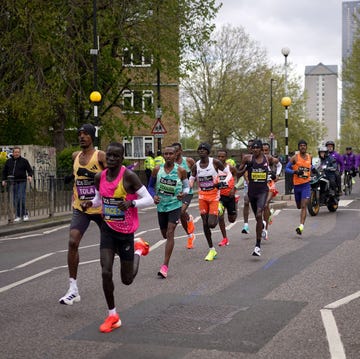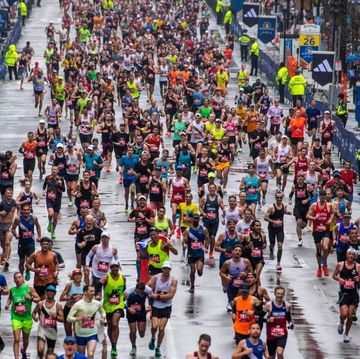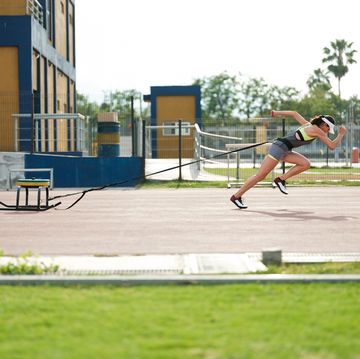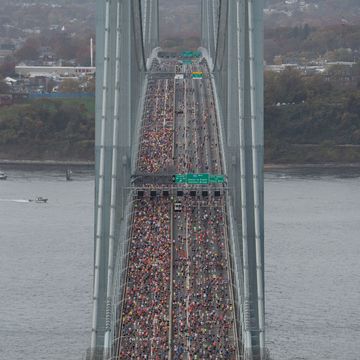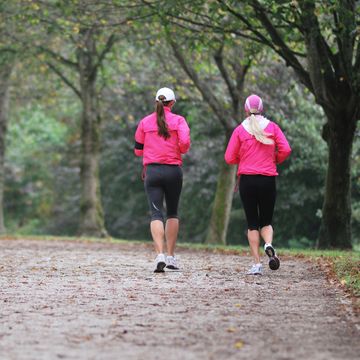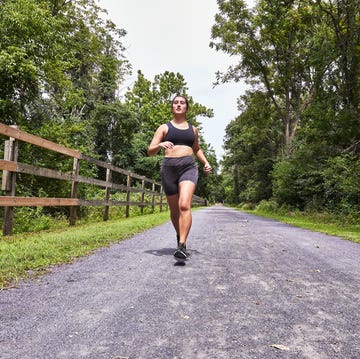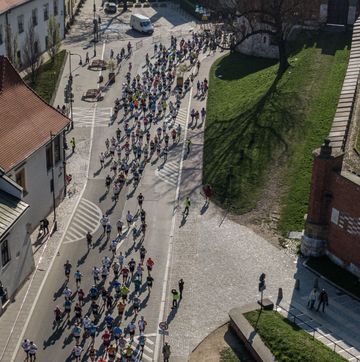Jeff Johnson is on his way to the 2012 U.S. Olympic trials, but instead of taking a first-class flight--which, as Nike's first-ever employee 48 years ago, he most likely could afford--he prefers to drive there from his Lebanon, N.H., home. Armed with a lifetime's worth of running memories and 700 miles left to get to Eugene, Ore., he picks up a reporter in his gray Subaru at the Salt Lake City Airport. Flashing a teeth-baring grin, the white-haired Johnson still dons the Swoosh from head (his sunglasses) to toe (his beloved Nike Free 3.0s, which are no longer made, but as luck would have it, he found along the way at a factory outlet store in Iowa).
Johnson, 70, is the kind of guy who sets out on a 3,050-mile trip without making a single hotel reservation or mapping out any stopping points along the route west. Though he carries a cell phone in the car, he insists that he never uses it. Year-old messages later retrieved on it confirm that to be true. The open itinerary doesn't seem to faze him. He and his new passenger will travel according to the rhythm of the road and end up in Eugene in three days, completing Johnson's 18th cross-country road trip. It leaves plenty of time to get to know this deep thinker who's contributed much to the distance running culture in America.
Johnson swears he doesn't have a personal story worthwhile enough to warrant a magazine feature. "I have no idea what you're going to write about," he repeats over and over again as he veers on the highway. He loves to talk about running, but when the conversation turns toward his own routine, he all but apologizes for his current state of fitness. It isn't tame by civilian standards, but, to a guy at the forefront of the running boom, his biweekly 40-minute slogs (broken up by walking breaks) feel like the epilogue to a grand novel. Just the other day a rather large woman in her 20s tackling the first run of her life easily swept past him on the riverside trail near his house, he laments. He hasn't seen her since. "I'm glad to not run into her again," he says shaking his head. "She'll smoke me."
In his mind, Johnson is still a lithe teenager striding across the trails of northern California, sights set on breaking 4:30 for the mile. In reality, the weight of time now makes three miles feel like a marathon. His once-bouncy gait has returned to earth after grinding out an estimated 60,000 lifetime miles. He understands this is what happens to an aging body--muscles tighten like rubber bands, ligaments start to snap and pull, and good runs occur about once every two weeks--and he's been trying to accept it for the past 25 years.
One Good Idea
Unlike most people who take up running to accomplish a goal, lose weight or join a team, Johnson's initial inspiration was survival. "We had gangs in third grade," he remembers. "Mike Pallet had like 50 kids in his and then there was me. At recess they had 15 minutes to pummel me to death and they never caught me."
The following year Johnson picked up a copy of Boy's Life and read an article on Charlie Paddock, the fastest man in the world. Paddock's training schedule seemed easy. Run 50 meters three times. The next day sprint 100 meters, once. Silly stuff. But there was one tough component--the 1-mile warm-up. "I thought, 'If I am going to be better than Charlie Paddock, I better do the hard thing,' so I emphasized that," Johnson says.
He evolved into a distance runner, the kind described as having a lot of "heart."
"You know Frank Shorter's statement that everybody ran a 4:30 mile in high school? I didn't," Johnson says. "I was the fifth-fastest miler on my Los Altos [San Francisco] high school team and ran 4:41."
His time, however, was the fastest among the incoming freshmen at the University of Colorado in 1959. Johnson's stay in Boulder proved to be short-lived. The following year he transferred to Stanford University on a whim. "Apparently, they shared the same whim because they accepted me," he says. Little did he know that the decision would change his life.
In Palo Alto, Johnson met Phil Knight, who of course went on to become the founder and CEO of Nike. In 1965, Knight hired Johnson as the first full-time employee. (It was originally called Blue Ribbon Sports before being renamed Nike in 1971.) Johnson launched the company's East Coast factory in Exeter, N.H., and developed the first line of running shoes. Johnson's co-worker, Walt Chadwick, remembers Johnson testing out materials that had never been used before in the sports shoe industry.
"He came back from California once and had this rubber teddy bear in his hand," Chadwick says. "Jeff thought the same kind of rubber would be a really interesting insole. He got in touch with Mattel, who gave Nike an exclusive for the material that they called phylon. The elite runners loved those shoes."
Johnson's free-thinking approach chafed against anything that gave off a whiff of buttoned-up corporate air. He was notorious for bringing a book to important meetings, pretending like he wasn't paying attention, then saying something brilliant, Chadwick says.
In 1971 Johnson gave the company its most distinguishable asset: its name. He had read an in-flight magazine article about the great brand names that become household terms, such as Kleenex and Xerox. They had no more than two syllables and at least one exotic letter or sound in them with a Z, X or K. On a Thursday night that spring, Johnson drifted to sleep trying to dream up a catchy term that fit these parameters. The company desperately needed one. A huge order of new sample shoes was about to be shipped from Japan the following week and they were in danger of going out without any sort of branding.
At 6:30 a.m. on Friday morning, Johnson abruptly woke up from a sound sleep, shot up in bed and knew he had it. "I've had one good idea in my life and this was it," he says.
Johnson waited until it was later on the West Coast and called Nike headquarters.
"I got it," he told them. "Nike!"
Dead air.
"What the hell is that?" somebody asked. Johnson explained the story about iconic brand names, and that the word was also for the Greek winged goddess of victory.
"What else you got?" his co-worker asked.
One week went by before Johnson heard from anyone. "We've decided to call it Nike," his co-worker told Johnson over the phone. "Nobody liked it, but it seemed better than anything else."
Nike went public in 1980 and the stock market pressure shifted the culture from jeans and T-shirts to coats and ties. Johnson relocated from the factory in New Hampshire to headquarters in Beaverton and was put in charge of managing the running division. "I wasn't very good at the new job and I hated it," he says. "That went on for a year and a half."
Given Nike's tremendous success, the change was inevitable. It did, however, present a tradeoff: Despite Johnson's dislike of the business environment, the influx of investment dollars would eventually allow him to retire at 41. The company was growing at such a tremendous rate that Knight had to reorganize the roles of his top managers every six months. During an executive meeting in 1983, Knight reshuffled the roles of his highest-ranking deputies. As Knight looked for a new position for Johnson, Johnson momentarily found himself without a job. "The door was open," he says. "It was probably going to close in five minutes and I'd have another job, probably one I hated just as much as the one I had now and was bad at. I just went, 'I'm out of here.'"
Employee No. 1 walked out the door with no regrets.
Though he was tapped out at the time, Johnson fondly reflects on his 18-year career at Nike. "We ran that business like a cross country team and Nike was the best team I was ever on," he says through a wide smile.
An Active Retirement
Traveling north over the dry flatlands of western Idaho and into Oregon, Johnson decides to pack it in for the night in Ontario, a speck-of-dust town right off the interstate. He chooses the location because of Casa Jaramillo, a Mexican restaurant he enjoyed on an earlier trip. From there he pushes on to Bend, where he finds the town's Dairy Queen by relying on his instincts rather than his phone's GPS or the AAA map he keeps between the front seats. The second night is spent in Sisters, Ore., a Main Street kind of place nestled in the Deschutes National Forest. The area serves as a launching point for hikers scrambling up the nearby snow-capped peaks or a refueling station for said victorious climbers. According to Johnson's self-set fitness schedule, in which he works out six days per week, he is supposed to swim this afternoon, but he doesn't because the hotel pool is too crowded. Instead, he opts for core exercises in his hotel room.
Edging closer to Nike Country, it seems odd that for the man who named the company, Oregon never felt like home. After Johnson retired from Nike, he returned to his beloved New England to live a quiet life. He enjoyed the company of books and read about one per week, mysteries mostly. (Two rooms of his five-bedroom house, where he lives by himself, are dedicated to his library.) He returned to coaching, something he did when he worked at the Nike factory, and began serving as a volunteer assistant for the local high school running programs around Lebanon.
Even when Johnson stopped coaching teams, he was still offering guidance to promising up-and-coming athletes. In 2005, Kimball Union Academy basketball coach Dave Faucher tipped off his friend that he had a gangly 6-foot-5 player with explosive wheels on his team. Faucher arranged a midwinter meeting between Johnson and the high school senior, who lived in nearby Meriden. When they met, Andrew Wheating told Johnson he wanted to be a top 5K runner. Johnson recommended that Wheating keep track of his weekly miles and run every day. "I thought that was ridiculous . . . and absurd," Wheating says.
Johnson's encyclopedic knowledge of the sport, however, convinced Wheating to do it. Besides sharing the nuts and bolts of training, Johnson transformed the budding talent into a middle-distance specialist and filled out his regimen with plyometrics. "He showed me several walking drills that help strengthen the smaller stabilizing muscles around your calves that I frequently do today, although I get a lot of odd looks walking pigeon-toed with my heels high off the ground," Wheating says.
Their short time together--one season of track--was enough for Johnson to reach out to Vin Lananna, the former University of Oregon coach, and tell him about Wheating's potential. The Ducks ultimately recruited Wheating in 2006 and he went on to make the 2008 and 2012 U.S. Olympic teams.
It wasn't the first time Johnson and Lananna collaborated. The longtime friends go all the way back to when Lananna lived in Hanover, N.H., and coached at Dartmouth. "Where some people look at a sky and see the clouds, Jeff will see the blue of it," says Lananna. "We don't always see things the same, but when our conversation is over I at least know he has listened to my perspective. It's unusual that someone can be so open-minded, yet stay singularly focused on a project."
In the late 1990s, Johnson and Lananna created the Nike Farm Team, a training group for post-collegiate athletes based at Stanford, where Lananna coached at the time. During this period, Johnson moved to the Bay Area and ran the day-to-day practices. His involvement had always been focused on the startup phase, so he handed the Farm Team off to Frank Gagliano in 2001 and returned to New Hampshire. The club moved to Eugene in 2006 and morphed into the Oregon Track Club, of which Wheating and fellow Olympians Nick Symmonds and Ian Dobson are members. "It's one thing to have good ideas and another to make that idea come to fruition like Jeff did," says Lananna, an OTC supporter. "He built up a sense of loyalty, which he does everywhere he goes. He is a genuine, authentic and passionate person."
Strength of a Runner
Johnson seemed to have it made. An early retirement. A healthy life savings. The freedom to do what he enjoyed. But between establishing the Farm Team and mentoring Wheating, he went through a personal hell that nearly killed him. On Tuesday night, May 3, 2004, "The Sopranos" had just ended when Johnson, then 62, felt like he'd been hit by lightning. A stroke seized his body and cut off oxygen to his brain. When he was delivered to the hospital at 2:30 a.m. he couldn't coordinate any faculties that were split down the middle of his head: tongue, eyes and vocal cords. The right side of his body felt numb.
The following morning Johnson had to undergo an MRI. As two big bruisers lifted him up from the bed to the gurney, Johnson tried to see if he could stand up--he hadn't done that since he'd arrived at the emergency room. Johnson let out a wild grunt that startled the aides and they accidentally let go of him. "In about a second they came to their senses and grabbed me, but in that one second I found that I could balance," Johnson says. A voice in his head told him, "This is no big deal. We can handle this."
He spent the next 40 days in the hospital and credits his recovery to his life as a runner. "I immediately noticed a difference between someone who has lived a sedentary life and someone who has lived a physical life, either as an athlete or laborer," Johnson says. "The athletes are knocking themselves out in the rehab room. They know that if they try it again and again they are going to improve."
On the first day in the hospital, a psychologist told Johnson he would experience black moods, but he says he never did. Instead, the more frustrated he became when he couldn't complete certain tasks, the harder he worked to heal. He looked at every exercise like doing repeat quarters. After 50 years of working out, his body was familiar breaking down tissue, resting and recovering, and doing it all over again the next day.
Before Johnson could drive again--he needed to pass a DMV test--he began running 50-yard dashes on the grass in front of his house, finding the faster he ran, the easier it was to balance. So he pushed himself hard. The day he was finally approved to drive, the first place he went was to his favorite riverside trail. "Until the third or fourth week, the possibility that I would never get out of a wheelchair was real. I could accept it on an intellectual level, but I really didn't believe it," he says.
Final Destination
The first place a runner usually visits in Eugene is the looping wood-chip trail system named after Steve Prefontaine. Upon arrival in town, that's where Johnson goes to pay his respects. When he lived in Portland, Johnson had the privilege of watching Pre compete often at Hayward Field. Over the years, he's collected his thoughts about what made Pre an icon and shares them with high school runners when he speaks at camps, clinics and races. "The effect Pre had on us in the stands is that he made us feel better about ourselves," Johnson says. "He was not a talented runner in the way that Frank Shorter or Galen Rupp float over the track. Prefontaine went over the track like a tractor. He made running look hard. He was out there suffering and he opened a vein for you."
His voice gets louder, his words faster. "You didn't even have to understand track. You could walk in off the street and be inspired by this guy," Johnson says. "And when you left Hayward Field you felt better about yourself. You thought, 'I can take a chance, I can dare to do something.'"
When the Olympic trials conclude, he packs up his gray Subaru and drives back home to add these memories and photos to those captured over the past 50 years.
An avid photographer, Johnson snapped classic images of the many distance wunderkind in the 1960s and 1970s. They are part of nearly 100,000 sports photographs Johnson has taken in his lifetime. Currently, they are all stored in his basement. Johnson is in the process of digitizing them. So far, with Chadwick's help, they've converted about 12,000.
Then there are the three library-style drawers where Johnson keeps thousands of note cards scribbled with quotes he's come across over the years. They aren't directly about running, but their messages apply to running. He doesn't yet know what he'll do with all of the pictures, but he has plans for the quotes. Eventually, he'll compile his favorites into a book for runners. If he were to add some wisdom of his own, he'd choose something that sums up his long perspective on running. It didn't come to him until later in life, well after he'd chased personal records, helped build Nike and coached youth runners. Maybe it was his recovery from his stroke that really hammered it home.
"The meaning of running grows over time," he says. "Even when you are done with it, it is not done with you."
Matt McCue is a frequent contributor to Running Times and the author of An Honorable Run. He can be reached at matt@anhonorablerun.com.


